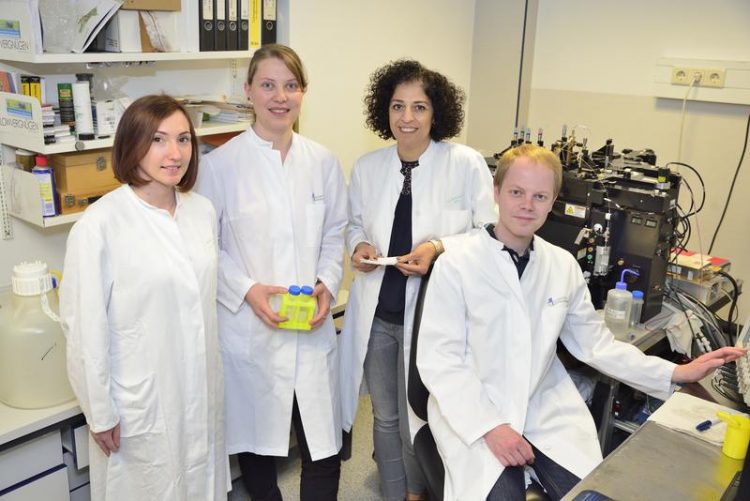Fighting life-threatening bacteria without antibiotics

Tracked down the mechanisms of dangerous infections in patients with cirrhosis of the liver: Alisa Ismaili, Lisa Mareike Assmus, Carl-Philipp Hackstein, Dr. Zeinab Abdullah (from left). © Photo: Rolf Müller/UKB-UKom
Each year, about 170,000 people die of complications of hepatic cirrhosis in Europe. Frequent causes of the widespread disease include alcohol abuse, fatty liver hepatitis, and chronic viral hepatitis. Liver cirrhosis develops gradually over a period of years and decades.
Liver cells die and get replaced by connective tissue. The scar tissue blocks the flow of blood through the liver leading to increased pressure in the blood vessels in the intestine and thus to the leakage of intestinal bacteria, which reach the liver via the blood.
“About one-third of the fatal cases of hepatic cirrhosis are attributable to bacterial infections”, says Prof. Dr. Jonel Trebicka, from the Department of Internal Medicine in the University Hospital Bonn, who is participating in the study and has been studying liver cirrhosis for many years. It has long been known that patients with hepatic cirrhosis have impaired immunity.
The exact causes were largely unknown. The team of Dr. Zeinab Abdullah at the Institute for Experimental Immunology in the University Hospital Bonn and Prof. Dr. Percy Knolle from the Institute of Molecular Immunology in the Technical University Munich, together with colleagues from the Department of Internal Medicine, LIMES-Institute in the University of Bonn and the RWTH University Hospital Aachen has now discovered the processes behind the attenuation of the immune system.
Collapse of the immune function of the macrophages
In mice suffering from liver cirrhosis, the scientist observed a sustained production of Type-1 interferon in response to the intestinal bacteria by immune cells responsible for defense against infection, namely macrophages and monocytes in the liver. When these immune cells were then infected by a small number of the pathogenic bacteria, Listeria, the production of Type-1 interferon massively increased.
As a consequence, the immune-regulatory factor interleukin-10 was release, which led to a defect in the anti-bacterial functions of the macrophages and thus to a fatal course of infections.
The scientists also performed these studies on human monocytes from the blood of cirrhosis patients. Dr. Zeinab Abdullah, a group leader at the Institute for Experimental Immunology in the University hospital Bonn said: “Following infection with pathogenic bacteria, we also observed highly elevated production of Type-1 interferon and interleukin-10 by monocytes from cirrhosis patients”.
“Our results identify the blind spot of the immune system that is responsible for the failure of the immune response to bacterial infections”.
Approaches for new diagnoses and therapies
Further experiments identified new therapeutic options: Mice that are unable to produce Type-1 interferon were protected against Listeria infection despite the migration of the gut bacteria into the liver, because their immune cells didn't produce high levels of Type-1 interferon and IL-10 after Listeria infection.
“The groundbreaking finding of our study is that we might be now able to treat a life-threatening bacterial infection without antibiotics, simply by strengthening the immune response”, says Prof. Dr. Percy Knolle of TU Munich. According to the researchers, this give rise to hope for new therapeutic options.
“When the formation of Type-1 interferon in the liver cells is blocked by suitable substances, there is a prospect of reinvigorating the immune system”, adds Professor Knolle. However, this very promising approach must first be confirmed in clinical studies.
Publication: Gut microbial translocation corrupts myeloid cell function to control bacterial infection during liver cirrhosis, “Gut”, DOI: 10.1136/gutjnl-2015-311224
Contact for the media:
Dr. Zeinab Abdullah
Institute for Experimental Immunology
Bonn University Medical Center
Tel. 0228/28711038
E-Mail: Zeinab.Abdullah@ukb.uni-bonn.de
Prof. Dr. Percy A. Knolle
Institute of Molecular Immunology / Experimental Oncology
Technical University of Munich
Tel. 089/41406920
E-mail: percy.knolle@tum.de
Media Contact
More Information:
http://www.tum.deAll latest news from the category: Health and Medicine
This subject area encompasses research and studies in the field of human medicine.
Among the wide-ranging list of topics covered here are anesthesiology, anatomy, surgery, human genetics, hygiene and environmental medicine, internal medicine, neurology, pharmacology, physiology, urology and dental medicine.
Newest articles

Innovative vortex beam technology
…unleashes ultra-secure, high-capacity data transmission. Scientists have developed a breakthrough optical technology that could dramatically enhance the capacity and security of data transmission (Fig. 1). By utilizing a new type…

Tiny dancers: Scientists synchronise bacterial motion
Researchers at TU Delft have discovered that E. coli bacteria can synchronise their movements, creating order in seemingly random biological systems. By trapping individual bacteria in micro-engineered circular cavities and…

Primary investigation on ram-rotor detonation engine
Detonation is a supersonic combustion wave, characterized by a shock wave driven by the energy release from closely coupled chemical reactions. It is a typical form of pressure gain combustion,…



